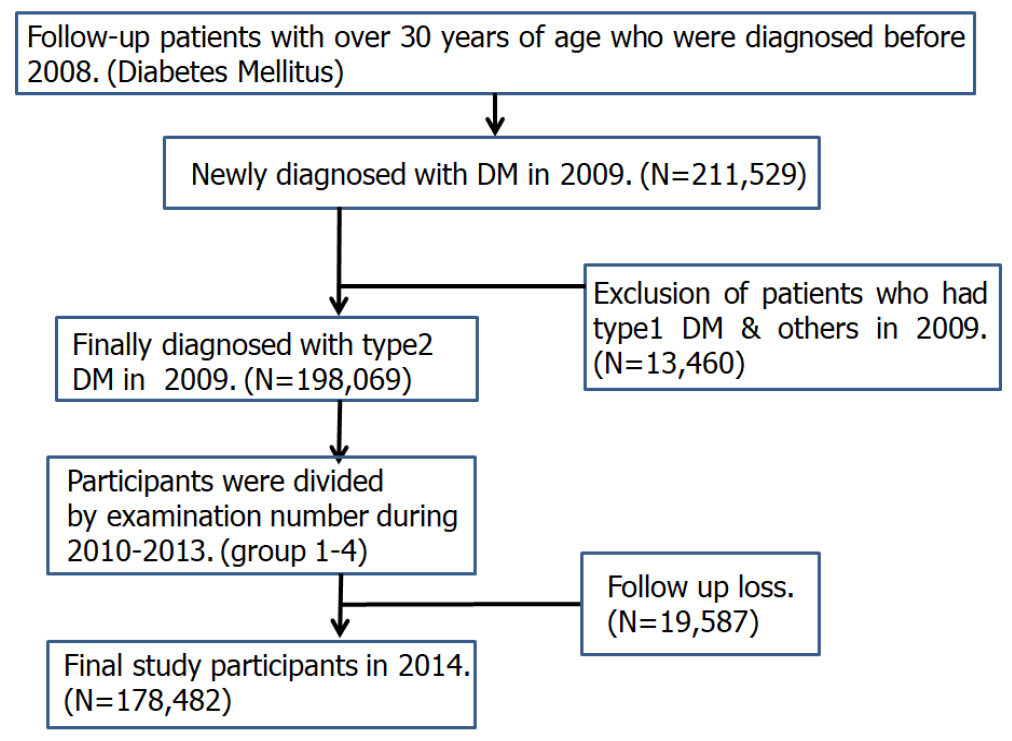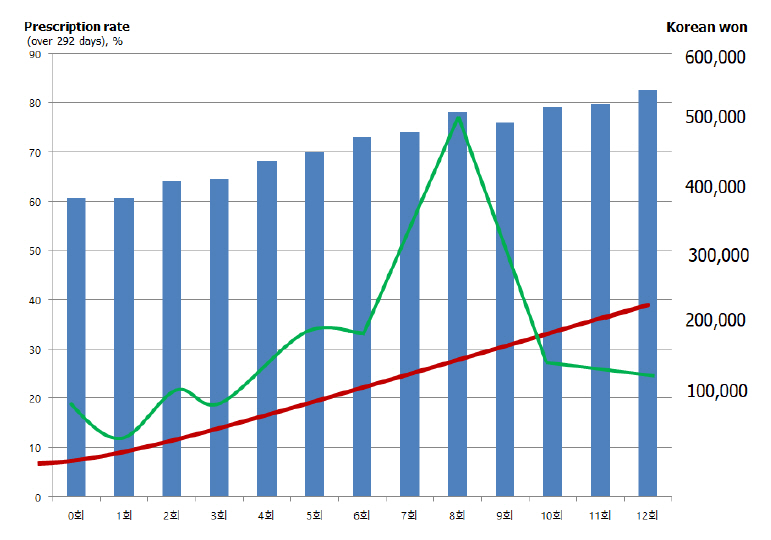Korean J Health Promot.
2020 Dec;20(4):175-181. 10.15384/kjhp.2020.20.4.175.
Changes in Indicators after Assessment of Diabetes Mellitus Adequacy Evaluation: Korean Health Insurance Review and Assessment Service Data 2010-2015
- Affiliations
-
- 1Department of Family Medicine, Yeung-Nam University Medical Center, Yeung-Nam University College of Medicine, Daegu, Korea
- 2Department of Healthcare Review, Health Insurance Review & Assessment Service, Wonju, Korea
- 3Department of Statistics and Actuarial Science, Soongsil University, Seoul, Korea
- KMID: 2509874
- DOI: http://doi.org/10.15384/kjhp.2020.20.4.175
Abstract
- Background
The Korean Health Insurance Review and Assessment Service has conducted diabetes medical adequacy evaluation projects since 2010. This study aimed to evaluate the medical adequacy of type 2 diabetes mellitus patients after the assessment project and help establish the direction of future projects.
Methods
Using data from the Health Insurance Review & Assessment Service (2010-2015), chi-square tests and t-tests were used to analyze the enforcement rate according to a combination of items for appropriate management methods. Logistic regression and linearity test were performed to assess the relationships among the evaluation group, appropriate test items, and prescription rate.
Results
We found that 33.6-39.8% of patients did not undergo any diabetes-related tests. Only about 7% of hemoglobin A1c (HbA1c) tests were performed, and 36% of cases were tested simultaneously with serum lipid profile tests. As age increased, the number of days taken to prescribe diabetes medications also increased. The prescription rate of diabetes drugs for 292 days or more was 61% in patients who had not been tested for adequacy, and the average prescription rate increased as the number of tests increased.
Conclusions
In older adults with a high prevalence of diabetes, it is necessary to establish a test rate for proper management of diabetes, including HbA1c, and related test items to increase the average prescription rate.
Figure
Reference
-
1. Korean Statistical Information Service. Causes of death [Internet]. Daejeon: Statistics Korea; 2018 [Accessed 2019 Sep 9]. Available from: https://kosis.kr/eng/search/searchList.do.2. Zimmet P, Alberti KG, Shaw J. Global and societal implications of the diabetes epidemic. Nature. 2001; 414(6865):782–7.
Article3. Chen L, Magliano DJ, Zimmet PZ. The worldwide epidemiology of type 2 diabetes mellitus--present and future perspectives. Nat Rev Endocrinol. 2012; 8(3):228–36.
Article4. Choi YJ, Kim HC, Kim HM, Park SW, Kim J, Kim DJ. Prevalence and management of diabetes in Korean adults: Korea National Health and Nutrition Examination Surveys 1998-2005. Diabetes Care. 2009; 32(11):2016–20.
Article5. Jeon JY, Ko SH, Kwon HS, Kim NH, Kim JH, Kim CS, et al. Prevalence of diabetes and prediabetes according to fasting plasma glucose and HbA1c. Diabetes Metab J. 2013; 37(5):349–57.
Article6. Korean Diabetes Association. Korean diabetes fact sheet 2015 [Internet]. Seoul: Korean Diabetes Association;2011. [Accessed 2016 Aug 18]. Available from: https://www.diabetes.or.kr/pro/news/admin.php?category=A&code=admin&number=1546&mode=view.7. Korea Centers for Disease Control and Prevention (KCDC). The Seventh Korea National health statistics National Health and Nutrition Examination Survey. Seoul: KCDC;2018. p. 1–402.8. Hong JS, Kim JY, Lee EM. A study to management method of appropriate state of affairs for chronic diseases-production of evaluation index for appropriate management of diabetes mellitus. Wonju: Health Insurance Review & Assessment Service;2009.9. Jung SH, Woo KS, Choi CS, Hong JS, Son CW. Management method of chronic diseases in private clinics-focus to appropriate assurance for a management cost of chronic diseases. Wonju: Health Insurance Review & Assessment Service;2009.10. Kim SR, Lee KS, Lee SH, Kim JY. A study for appropriate management method of diabetes mellitus. Wonju: Health Insurance Review & Assessment Service;2008.11. Centers for Disease Control and Prevention (CDC). Behavioral Risk Factor Surveillance System (BRFSS) 2010 Survey Data and Documentation [Internet]. Atlanta: CDC;2010. [Accessed 2019 Sep 9]. Available from: https://www.cdc.gov/brfss/annual_data/annual_2010.htm.12. Shekelle PG, Vijan S. Quality indicators for the management of diabetes mellitus for vulnerable older person. RAND Health Working Book(WB-187);2004.13. American Diabetes Association. Microvascular complications and foot care: standards of medical care in diabetes—2018. Diabetes Care. 2018; 41(Suppl 1):S105–18.14. Choudhry NK, Shrank WH, Levin RL, Lee JL, Jan SA, Brookhart MA, et al. Measuring concurrent adherence to multiple related medications. Am J Manag Care. 2009; 15(7):457–64.15. Rozenfeld Y, Hunt JS, Plauschinat C, Wong KS. Oral antidiabetic medication adherence and glycemic control in managed care. Am J Manag Care. 2008; 14(2):71–5.16. Hussey PS, Schneider EC, Rudin RS, Fox DS, Lai J, Pollack CE. Continuity and the costs of care for chronic disease. JAMA Intern Med. 2014; 174(5):742–8.
Article17. Peikes D, Chen A, Schore J, Brown R. Effects of care coordination on hospitalization, quality of care, and health care expenditures among medicare beneficiaries: 15 randomized trials. JAMA. 2009; 301(6):603–18.
- Full Text Links
- Actions
-
Cited
- CITED
-
- Close
- Share
- Similar articles
-
- A guide for the utilization of Health Insurance Review and Assessment Service National Patient Samples
- Evaluation of Appropriate Management of Chronic Obstructive Pulmonary Disease in Korea: Based on Health Insurance Review and Assessment Service (HIRA) Claims
- Indicators and Qualitative Assessment of Lung Cancer Management by Health Insurance Review and Assessment Service (HIRA) of Korea in 2015
- Impact of Health Insurance Type on the Quality of Hemodialysis Services: A Multilevel Analysis
- Emerging New Era of Mobile Health Technologies



